Want A Healthier Home? Experts Say This One Product Could Make A Huge Difference
Turns out humidity is bad for more than just our hair.

February 5, 2023 Our editors have independently chosen the products listed on this page. If you purchase something mentioned in this article, we may It seems like humidifiers are getting all the love—but if you have excess moisture in your home, a dehumidifier is what you really need. The best dehumidifiers are easy to use and can quickly reduce humidity levels to improve air quality in your home (thereby, bettering your health). Dehumidifiers are often available at an affordable price point and can be conveniently run in all areas of the home, including bathrooms, basements, and bedrooms. In addition to making musty, damp spaces more comfortable to live in, dehumidifiers can also have a positive impact on your well-being. Research shows that high humidity levels can promote the growth of mold1 (which, of course, is not healthy for anyone). In fact, one study reported that mold or excess dampness in the home caused 21% of United States asthma cases2. Mold has also been tied to symptoms such as dyspnea, wheezing, coughing, respiratory infections, bronchitis, allergic rhinitis, eczema, vocal cord dysfunction, and upper respiratory tract symptoms3. By regulating indoor humidity levels, you can help prevent these irritants. All that considered, choosing the right dehumidifier can certainly feel overwhelming. Using research, customer feedback, and insight from experts, we found the best dehumidifiers available in 2023. So, yes, you can now breathe a sigh of relief.
What is a dehumidifier?
Dehumidifiers, which come in all different sizes, are devices that draw excess moisture out of the air. This moisture is then turned into water and stored in the machine’s tank where it is eventually discarded (either manually or via an internal pump). Some models have an option for continuous draining, so the collected water is automatically drained using a hose. Opposite to humidifiers, the purpose of a dehumidifier is to dry up a space.
Who should use a dehumidifier?
Dehumidifiers can benefit many people. “Those with allergies or asthma should consider using a dehumidifier, as it can help to keep allergens such as dust mites and mold under control,” explains Leah Alexander, MD, FAAP. Mold, mildew, and dust mites thrive in humid conditions, so using a dehumidifier can help prevent these allergens from growing or spreading. Experts recommend keeping indoor relative humidity under 60%, ideally between 30 and 50 percent4.
Per Alexander, those who live in humid climates or areas that frequently experience flooding or leaking may benefit from a dehumidifier. “Homes with basements, bathrooms, laundry rooms, or areas that tend to remain damp due to poor ventilation can also benefit,” she adds.
If your home is on the dry side, it is best not to use a dehumidifier. According to research, very low humidity levels in the home can dry out the protective mucous membranes of the nose and throat, making you more susceptible to illnesses such as the common cold5. Since both very high and very low humidity levels can cause issues, it is important to keep indoor humidity at an optimal level.
How to use a dehumidifier:
Dehumidifiers should be placed in rooms with high humidity. Alexander advises using a dehumidifier for a good portion of the day for the best results. “Generally, you should run your dehumidifier for at least 8 to 10 hours each day in order to maintain proper humidity levels and reduce moisture content in your home,” she says.
The benefits of a dehumidifier.
Again, a huge benefit of using a dehumidifier is that it helps lower the amount of moisture in the air, reducing the chances of mold, mildew, and other allergens. “This can be beneficial for people with allergies or asthma, as well as anyone who would like to keep their home more comfortable and humidity-free,” Alexander elaborates.
However, dehumidifiers are not without their drawbacks. For instance, Alexander points out that using a dehumidifier can raise your energy costs, some designs are a bit loud, and others can raise the temperature in smaller rooms. Additionally, if you choose a dehumidifier that does not have continuous drainage or a pump, remember you will have to dump out the water tank manually.
How to choose a dehumidifier.
There are a few factors to consider to determine the best dehumidifier for you. Mandy DeVries, M.S.-RCL/Ed, RRT, RRT-NPS, Director of Education at the American Association for Respiratory Care says to first think about the size and capacity. “This will determine the coverage area of your house and how often it needs to be emptied,” she explains.
Other important considerations include noise level, energy efficiency rating, and if you want something portable. Reading online reviews for each model and taking note of unique features can be extremely helpful. “Ultimately, the goal is to purchase a dehumidifier that meets your specific needs while improving indoor air quality,” DeVries adds.
How we picked:
High-quality products last longer and are often safer to use. Because of this, we focused on quality when deciding which models to include.
We read hundreds of customer reviews to understand what people like and dislike about each dehumidifier. Negative reviews also helped us pinpoint potential cons, even for the best products.
We’ve called attention to any unique feature for each dehumidifier. This will help you decide which model is best for your lifestyle and needs.
Dehumidifiers vary in price, which is why we included a variety of options that fit into different budgets.
Our picks for the best dehumidifiers of 2023:
Best for small spaces: ProBreeze Electric Mini Dehumidifier

Pros:
Can be used in RVs, boats, and campersLightweightWater capacity: 1.5 liters
Collection tank capacity: 52 ounces
Drainage style: Manual
Coverage area: 250 square feet
Dimensions: 6.6" x 9" x 12.69"
Max noise level: Not listed
Weight: 3.3 pounds
If you have a damp bathroom or laundry room, this mini dehumidifier may be all you need. A smaller model, it comes in at a little over 12 inches high—but don’t be fooled, it works wonders in small spaces up to 250 square feet. This dehumidifier can even be used in RVs, trailers, and boats.
This option removes up to 18 ounces of moisture per day and operates without a compressor, which keeps the machine incredibly quiet. An auto shut-off function prevents it from running overtime, and the simple-to-use water outlet makes for easy draining. Keep note that, like most dehumidifiers, it functions best in temperatures between 59 to 86 degrees Fahrenheit.
With over 12,000 five-star Amazon ratings, this dehumidifier is a cult-favorite among customers who love how scaled-down and quiet it is. One reviewer shares, “Perfect for a small space (I use it in my kitchen on humid days to reduce moisture when preparing certain foods) and the noise level is not particularly noticeable. It works well—I've noticed the difference since I've started using it. Well-priced also compared to other options.”
Best with pump: TOSOT 50 Pint with Internal Pump
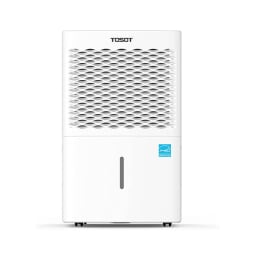
Pros:
Covers up to 4,500 square feetEnergy-efficientSuper quietWater capacity: 50 pints
Collection tank capacity: Not listed
Drainage style: ManualContinuousInternal Pump
Coverage area: 4,500 square feet
Dimensions: 11.38” x 14.76” x 24”
Max noise level: Not listed
Weight: 53.7 pounds
Efficiency is the name of the game for this dehumidifier. Its real-time humidity display helps you keep track of moisture levels, with a full-bucket indicator that alerts you when the tank is full. This particular model has three options for drainage: manual drain, which involves removing the bucket yourself and pouring the water out; gravity drain, which utilizes gravity to drain water continuously via a hose; and an internal pump option that pushes water sideways or vertically up to 16 feet (using a line or tube) once the tank is almost full. This unique feature can be especially beneficial when trying to rid moisture from damp basements.
As for safety precautions, this dehumidifier has overflow protection (no messes or leaks on the floor), is made from fireproof materials, and is UL-approved, meaning it meets the highest safety standards. What’s more, it also comes with a timer that allows you to schedule delayed start times in 2- to 4-hour increments.
As expected, customers rave that this model vastly improves their living spaces. One reviewer notes, “This dehumidifier has worked wonderfully! Placed it in my basement which was damp and over 80% humidity, and in a week it had dried it out and had the humidity down to 50%. The pump is a must. I hooked it up to the washing machine drain and just left it to do its thing. The machine continues to maintain a comfortable humidity in the basement, and mold is no longer a problem.”
However, some people do comment that this model is a bit loud and may be better suited for basements or garages, where the noise won't be a distraction.
Advertisement
This ad is displayed using third party content and we do not control its accessibility features.
Best for basements: Midea Cube 50 Pint Dehumidifier
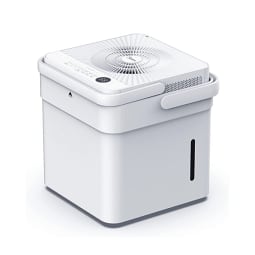
Pros:
Can be controlled via the Midea Cube Air appEnergy-savingExtendable designWater capacity: 50 pints
Collection tank capacity: Not listed
Drainage style: ManualContinuous
Coverage area: 4,500 square feet
Dimensions: 14.45" x 14.76" x 14.57"
Max noise level: Not listed
Weight: 42 pounds
One of the most versatile options, this dehumidifier can be used in its nested or expanded form, depending on room size or how much humidity you’d like to get rid of. To expand the device, simply lift and twist the top. The adjustable design is especially great for storage purposes.
What’s more, this dehumidifier can be controlled via the brand’s app. This allows you to monitor water and humidity levels even while you’re not home. The machine can collect up to 50 pints of moisture per day and has an auto restart function, which comes in handy if there are any power disruptions. A nifty auto-defrost function ensures that the tank's water doesn’t freeze in lower temperatures.
Customers are pleased with this dehumidifier and love how quickly it sucks up stubborn moisture in large rooms, such as basements. One writes, “Our humidity in the basement is already down from 67% to 49%. It’s very quiet though in the basement it would not be an issue for us.” Another happy customer adds, “I am so happy with the quality of this product! We suffered a devastating flood in our basement after hurricane Ida, including losing our dehumidifier. At first this one ran constantly, which worried me but now it rarely comes on. I have it set to 40% humidity. It's pleasant going in our basement; it never smells moldy or like mildew. It's doing a great job! The basement is about 900 square feet.”
Best portable: Frigidaire FFAD2233W1 Dehumidifier
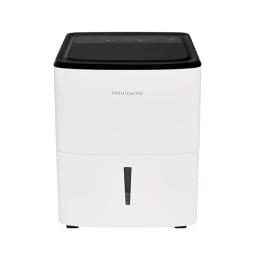
Pros:
Comes with caster wheels, side handles, and carrying handlesCan operate at low temperatures down to 41 degrees FahrenheitEasy-to-clean filterCons:
Can be loud at its highest modeWater capacity: 22 pints
Collection tank capacity: 1.14 gallons
Drainage style: ManualContinuous
Coverage area: 330 square feet
Dimensions: 11.34" x 15.5" x 19.78"
Max noise level: 49dBA
Weight: 36.3 pounds
Looking for a portable dehumidifier you can transport from room to room? With caster wheels and side handles, this handy pick is easy to move throughout your home to eliminate excess moisture. It works best in small to medium rooms, therefore is an excellent choice for bedrooms, laundry rooms, and garages. Short on space? Simply wheel the machine into storage when you don’t need it.
A helpful control panel allows you to set your desired humidity level and check the device’s water levels. If you’re not using the continuous drain option, the machine will automatically shut off when the water tank is full. Its front-loading bucket, handle, and splash guard make the emptying process simple—plus, the removable filter can be hand-washed in the sink. While most humidifiers should only be used in spaces between 59 and 86 degrees Fahrenheit, this particular model is suitable for temperatures down to 41 degrees Fahrenheit.
With nearly 5,500 five-star Amazon reviews, this dehumidifier is praised for its convenience, high-end features, and bucket design. “This dehumidifier is small but mighty,” one reviewer raves. “With Oklahoma’s high humidity, I have been pulling over two of the detachable buckets of water, which are at least a gallon, out of the air daily. I use the water for my potted plants, so this product is a win-win. Portable and easily accommodated.”
Although the reviews are mainly positive, some do mention that the machine can be a bit noisy when running on the highest setting.
Advertisement
This ad is displayed using third party content and we do not control its accessibility features.
Best design: Honeywell Smart WiFi Energy Star Dehumidifier
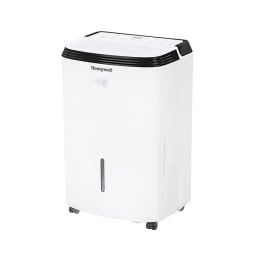
Pros:
Covers up to 4,000 square feetWi-Fi-enabledAnti-spill tank designCons:
May not be best for rooms with very high humidityWater capacity: 70 pints
Collection tank capacity: 14 pints
Drainage style: ManualContinuous
Coverage area: 4,000 square feet
Dimensions: 12.4" x 15.7" x 25.4"
Max noise level: 52dBA
Weight: 41.1 pounds
This sleek choice is Wi-Fi-enabled and can be controlled via the brand’s app. An included cord winder makes storage less messy, too. There’s no complicated setup with this one, but the brand does have a customer service hotline in case you do run into any issues or need assistance.
This durable model takes approximately 70 pints of moisture out of the air each day and comes with a drain tube if you’d like to use the continuous drain function. Covering up to 4,000 square feet, it works double-time to reduce dust in the air with a washable dust filter.
Most-loved for its techy features, elegant design, and easy installation, this dehumidifier gets great feedback on Amazon. One reviewer writes, “Main features that influenced this purchase was the Wi-Fi capability and the fact you could use a drain hose instead of having to constantly empty the bucket. The Wi-Fi setup was easy and took less than two minutes.” Others comment on how quiet it is compared to other options, and how easy it is to move around because of the built-in wheels.
Most negative reviews come from people who have issues with the app specifically.
Best for large rooms: HomeLabs 50 Pint Energy Star Dehumidifier

Pros:
Covers up to 4,500 square feetClimate Pledge FriendlyVery quietCons:
May raise the temperature of smaller roomersWater capacity: 50 pints
Collection tank capacity: 1.6 gallons
Drainage style: ManualContinuousPump
Coverage area: 4,500 square feet
Dimensions: 11.93" x 15.43" x 24.41"
Max noise level: Not listed
Weight: 40 pounds
Ideal for larger spaces, this powerful dehumidifier reduces moisture in the home and has an optional built-in pump compressor. The sleek design features built-in wheels for easy transport throughout your home. It operates quietly, so you don’t have to worry about the noise interfering with your television shows or work calls.
Each machine runs on a 24-hour cycle and automatically shuts off once the water tank is full. If you don’t opt to use the pump, you’ll just need to pour the water out manually, or use the drain outlet to install a hose for continuous draining. An Energy Star-certified product, this is an excellent choice for anyone who wants to use less energy.
Featuring a whopping 38,000 five-star ratings on Amazon, this popular choice gets a lot of love. If this customer’s detailed review doesn’t convince you, we don’t know what will: “I've purchased this dehumidifier three times now. Not because the first two had any problems, but because they worked so well on the spaces I've used them in. Whether it was the basement, garage, or poorly insulated apartment, the amount of water this machine extracts from the air is surprising and impressive. Most recently, it took the humidity in a 500 square foot space from around 65% down to 45% in about an hour or two. It's already begun to feel very good for my respiratory system. And in the aforementioned basement, it put an end to a longtime mold problem very quickly.”
One qualm a few people mention is that the machine’s humidistat operates in increments of five and is not always the most accurate.
Advertisement
This ad is displayed using third party content and we do not control its accessibility features.
Best budget: Simsen 95oz Dehumidifier
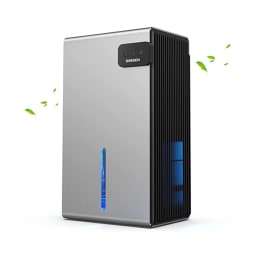
Pros:
Features a double dehumidification condenserUltra-quietComes with a sleep modeCons:
Included hose is low-qualityWater capacity: 34 ounces
Collection tank capacity: 95 ounces
Drainage style: ManualContinuous
Coverage area: 720-square feet
Dimensions: 5.55" x 8.26" x 13.77"
Max noise level: Not listed
Weight: 5.73 pounds
Featuring a double dehumidification condenser, this portable and affordable dehumidifier works well in rooms up to 720 square feet. An auto shut-off function makes it safe to run when you’re not home—so you won’t have to worry whether or not you left it on.
This unit features a high-power mode, which is great to use during the day, and a whisper-quiet sleep mode that’s particularly well-suited for nighttime. Another unique touch is the ambient “breathing atmosphere light” detail (but this can be turned off if you’re not a fan). The brand provides lifetime customer service and tech support 24 hours a day, which can be helpful if you ever need assistance.
As one reviewer puts it, “If you are looking for a dehumidifier look no further. This dehumidifier was well within the budget and did the job very well. I have about a 300 square foot basement and the dehumidifier had no issues keeping up. After it was running for about a day the basement was noticeably different, and it felt very comfortable to be down there. There's no need to purchase an expensive brand of dehumidifier when this one does the same job just as well.”
Although most users are satisfied with this dehumidifier, some wish it came with a few more features, such as the ability to restart automatically if the power cuts out.
FAQ:
How many hours a day should a dehumidifier run?
This depends on how much humidity you have in the home. Generally, Alexander advises running a dehumidifier between 8 to 10 hours per day and notes that the recommended goal is to have 30 to 50 percent indoor relative humidity. If you notice that your home has higher humidity levels, you may want to run it higher at longer periods of time.
What is the average lifespan of a dehumidifier?
The average lifespan of a dehumidifier varies based on quality and design. Be sure to purchase a durable, high-quality dehumidifier with features that fit your lifestyle.
Do dehumidifiers take mold out of the air?
According to experts, dehumidifiers cannot get rid of mold, but can help prevent the growth and spread of mold by lowering high humidity levels in the home.
At what temperature should you not run a dehumidifier?
Different models may be able to function at different temperatures, but, in general, most dehumidifiers are able to run between 59 and 89 degrees Fahrenheit. Alexander shares that anything lower than 50 degrees may cause the machine to freeze, whilevery hot temperatures can cause the dehumidifier to become a fire hazard. “It is best to adjust the setting on your unit accordingly and never leave it running unattended for long periods of time,” she cautions.
The takeaway.
If you live in a home that is prone to dampness or excess moisture, a dehumidifier can be beneficial to your health and well-being. Still not sure if this is the right appliance for your needs? Check out our picks for the best air purifiers for mold and the best humidifiers to learn more about the importance of air quality in the home.

 Tfoso
Tfoso 
































